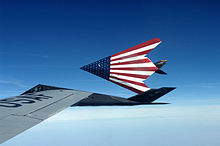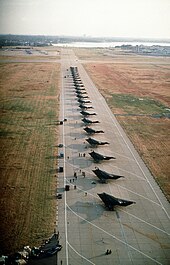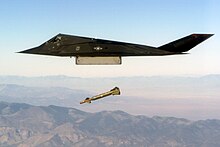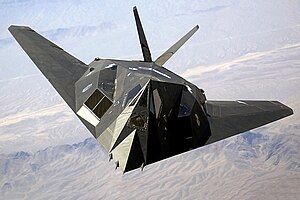This blog is use only for give you a detail about weapon, sorry about not showing the manufacture and etc.
Blogroll
Lockheed F-117 Nighthawk (Aircraft)
The Lockheed F-117 Nighthawk was a single-seat, twin-engine stealth ground-attack aircraft formerly operated by the United States Air Force (USAF). The F-117A's first flight was in 1981, and it achieved initial operating capability status in October 1983.[1] The F-117A was "acknowledged" and revealed to the world in November 1988.[4] A product of Lockheed Skunk Works and a development of the Have Blue technology demonstrator, it became the first operational aircraft initially designed around stealth technology. The F-117A was widely publicized during the Persian Gulf War of 1991. It was commonly called the "Stealth Fighter" although it was a ground-attack aircraft, making its F-designation misleading. The Air Force retired the F-117 on 22 April 2008,[2] primarily because of the fielding of the F-22 Raptor[5] and the impending introduction of the F-35 Lightning II.[6] Sixty-four F-117s were built, 59 of which were production versions with five demonstrators/prototypes. Development[edit] Background and Have BlueMain article: Lockheed Have Blue In 1964, Pyotr Ya. Ufimtsev, a Soviet mathematician, published a seminal paper titled Method of Edge Waves in the Physical Theory of Diffraction in the journal of the Moscow Institute for Radio Engineering, in which he showed that the strength of a radar return is related to the edge configuration of an object, not its size.[7] Ufimtsev was extending theoretical work published by the German physicist Arnold Sommerfeld.[8][9][10] Ufimtsev demonstrated that he could calculate the radar cross-section across a wing's surface and along its edge. The obvious conclusion was that even a large aircraft could be made stealthy by exploiting this principle. However, the airplane's design would make it aerodynamically unstable, and the state of computer technology in the early 1960s could not provide the kinds of flight computers which allow aircraft such as the F-117, and B-2 Spirit to stay airborne. However, by the 1970s, when a Lockheed analyst reviewing foreign literature found Ufimtsev's paper, computers and software had advanced significantly, and the stage was set for the development of a stealthy airplane.[11]The F-117 was born after combat experience in the Vietnam War when increasingly sophisticated Soviet surface-to-air missiles (SAMs) downed heavy bombers.[12] It was a black project, an ultra-secret program for much of its life, until the late 1980s.[13] The project began in 1975 with a model called the "Hopeless Diamond"[14][15] (a wordplay on the Hope Diamond because of its appearance). The following year, the Defense Advanced Research Projects Agency issued Lockheed Skunk Works a contract to build and test two Stealth Strike Fighters, under the code name "Have Blue".[16] These subscale aircraft incorporated jet engines of the Northrop T-38A, fly-by-wire systems of the F-16, landing gear of the A-10, and environmental systems of the C-130.[16] By bringing together existing technology and components, Lockheed built two demonstrators under budget, at $35 million for both aircraft, and in record time.[16] The maiden flight of the demonstrators occurred on 1 December 1977.[17] Although both aircraft were lost during the demonstration program, test data proved positive. The success of Have Blue led the government to increase funding for stealth technology. Much of that increase was allocated towards the production of an operational stealth aircraft, the Lockheed F-117A, under the program code name "Senior Trend".[18][19] [edit] Senior TrendThe decision to produce the F-117A was made on 1 November 1978, and a contract was awarded to Lockheed Advanced Development Projects, popularly known as the Skunk Works, in Burbank, California.[20] The program was led by Ben Rich, who called on Bill Schroeder, a Lockheed mathematician, and Denys Overholser, a computer scientist, to exploit Ufimtsev's work. The three designed a computer program called "Echo", which made it possible to design an airplane with flat panels, called facets, which were arranged so as to scatter over 99% of a radar's signal energy "painting" the aircraft.[11][21][22]The first YF-117A, serial number 79-0780, made its maiden flight from Groom Lake, Nevada on 18 June 1981,[23] only 31 months after the full-scale development decision. The first production F-117A was delivered in 1982, and operational capability was achieved in October 1983.[8][24] The Air Force denied the existence of the aircraft until 1988, when a grainy photograph was released to the public. In April 1990 two were flown into Nellis Air Force Base, Nevada, arriving during daylight and publicly displayed to a crowd of tens of thousands.[25] Five Full Scale Development (FSD) aircraft were built, designated "YF-117A".[26] The last of 59 production F-117s were delivered on 3 July 1990.[24][27] As the Air Force has stated, "Streamlined management by Aeronautical Systems Center, Wright-Patterson AFB, Ohio, combined breakthrough stealth technology with concurrent development and production to rapidly field the aircraft... The F-117A program demonstrates that a stealth aircraft can be designed for reliability and maintainability."[1] The aircraft maintenance statistics are comparable to other tactical fighters of similar complexity. Logistically supported by Sacramento Air Logistics Center, McClellan AFB, California, the F-117A was kept at the forefront of technology through a planned weapon system improvement program located at USAF Plant 42 at Palmdale, California.[citation needed] [edit] DesignationThe operational aircraft had the official designation of "F-117A".[28] Most modern U.S. military aircraft use post-1962 designations in which the designation "F" is usually an air-to-air fighter, "B" is usually a bomber, "A" is usually a ground-attack aircraft, etc. (Examples include the F-15, the B-2, and the A-6.) The F-117 is primarily a ground-attack aircraft so its "F" designation is inconsistent with the DoD system, but it is an inconsistency that has been repeatedly employed by the U.S. Air Force with several of its ground attack aircraft since the late 1950s, e.g., F-105, F-111, etc.The designation "F-117" seems to indicate that it was given an official designation prior to the 1962 U.S. Tri-Service Aircraft Designation System and could be considered numerically to be a part of the earlier "Century series" of fighters. The assumption prior to the revealing of the aircraft to the public was that it would likely receive the designation F-19 as that number had not been used. However there were no other aircraft to receive a "100" series number following the F-111. Soviet fighters obtained by the United States via various means under the Constant Peg program[29] were given F-series numbers for their evaluation by U.S. pilots, and with the advent of the Teen Series fighters, most often Century Series designations. As with other exotic military aircraft types flying in the southern Nevada area, such as captured fighters, an arbitrary radio call of "117" was assigned. This same radio call had been used by the enigmatic 4477th Test and Evaluation Squadron, also known as the "Red Hats" or "Red Eagles", that often had flown expatriated MiGs in the area, but there was no relationship to the call and the formal F-19 designation then being considered by the Air Force. Apparently, use of the "117" radio call became commonplace and when Lockheed released its first flight manual (i.e., the Air Force "dash one" manual for the aircraft), F-117A was the designation printed on the cover.[30] A televised documentary quoted a senior member of the F-117A development team as saying that the top-notch USAF fighter pilots required to fly the new aircraft were more easily attracted to an aircraft with an "F" designation for fighter, as opposed to a bomber ("B") or attack ("A") designation.[31] [edit] DesignThe F-117 is shaped to deflect radar signals and is about the size of an F-15 Eagle. The single-seat Nighthawk is powered by two non-afterburning General Electric F404 turbofan engines, and has quadruple-redundant fly-by-wire flight controls. It is air refuelable. To lower development costs, the avionics, fly-by-wire systems, and other parts are derived from the General Dynamics F-16 Fighting Falcon, McDonnell Douglas F/A-18 Hornet and McDonnell Douglas F-15E Strike Eagle. The parts were originally described as spares on budgets for these aircraft, to keep the F-117 project secret.The F-117 Nighthawk has a radar signature of about 0.025 m2 (0.269 sq ft).[32] Among the penalties for stealth are lower engine power thrust, due to losses in the inlet and outlet, a very low wing aspect ratio, and a high sweep angle (50°) needed to deflect incoming radar waves to the sides.[33] With these design considerations and no afterburner, the F-117 is limited to subsonic speeds. It also has serrated edges in places to scatter as much radar signals.[citation needed] The F-117A is equipped with sophisticated navigation and attack systems integrated into a digital avionics suite. It carries no radar, which lowers emissions and cross-section. It navigates primarily by GPS and high-accuracy inertial navigation. Missions are coordinated by an automated planning system that can automatically perform all aspects of an attack mission, including weapons release. Targets are acquired by a thermal imaging infrared system, slaved to a laser that finds the range and designates targets for laser-guided bombs. The F-117A's split internal bay can carry 5,000 lb (2,300 kg) of ordnance. Typical weapons are a pair of GBU-10, GBU-12, or GBU-27 laser-guided bombs, two BLU-109 penetration bombs, or two Joint Direct Attack Munitions (JDAMs), a GPS/INS guided stand-off bomb. [edit] Operational historyDuring the program's early years, from 1984 to mid-1992, the F-117A fleet was based at Tonopah Test Range Airport, Nevada where it served under the 4450th Tactical Group. Because the F-117 was classified during this time, the 4450th Tactical Group was "officially" located at Nellis Air Force Base, Nevada and equipped with A-7 Corsair II aircraft. The 4450th was absorbed by the 37th Tactical Fighter Wing in 1989. In 1992, the entire fleet was transferred to Holloman Air Force Base, New Mexico, where it was placed under the command of the 49th Fighter Wing. This move also eliminated the Key Air and American Trans Air contract flights to Tonopah, which flew 22,000 passenger trips on 300 flights from Nellis to Tonopah per month.F-117 pilots called themselves "Bandits". Each of the 558 Air Force pilots who have flown the F-117 have a Bandit number, such as "Bandit 52", that indicates the sequential order of their first flight in the F-117.[34] The F-117 has been used several times in war. Its first mission was during the United States invasion of Panama in 1989.[35] During that invasion two F-117A Nighthawks dropped two bombs on Rio Hato airfield. During the Persian Gulf War in 1991, the F-117A flew approximately 1,300 sorties and scored direct hits on 1,600 high-value targets in Iraq[1] over 6,905 flight hours.[36] Only 2.5% of the American aircraft in Iraq were F-117s, yet they struck more than 40% of the strategic targets.[37] F-117As dropped over 2,000 tons of precision-guided munitions and struck their targets with over an 80% success rate. "Although the 37th Tactical Fighter Wing Provisional and its 42 stealth fighters represented just 2.5 percent of all allied fighter and attack aircraft in the Persian Gulf, the F-117As were assigned against more than 31 percent of the strategic Iraqi military targets attacked during the first 24 hours of the air campaign."[36] It was one of very few U.S. or Coalition aircraft types to strike targets in downtown Baghdad. Its stealth characteristics protected it from the SAM and AAA-saturated environment of the city, and due both to its precision-guided weaponry and its avoidance of having to jettison ordnance in defensive maneuvers F-117 missions proved less likely to cause civilian casualties and collateral damage.[38] Following its move to Holloman AFB in 1992, the F-117A and the men and women of the 49th Fighter Wing were deployed to Southwest Asia on multiple occasions. On their first deployment, crews flew non-stop from Holloman to Kuwait, a flight of approximately 18.5 hours – a record for single-seat fighters that stands today.[1] The F-117 was subsequently used in Operation Allied Force in 1999, Operation Enduring Freedom in 2001, and Operation Iraqi Freedom in 2003. [edit] Combat lossOnly one F-117 (AF ser. no. 82-0806)[39] was lost to enemy action. It was shot down during a mission against the Army of Yugoslavia on 27 March 1999, during Operation Allied Force.[39] About 8:15 pm local time, SA-3s were fired from about 8 miles (13 km) away, launched by a Yugoslav version of the Soviet Isayev S-125 "Neva" (NATO name SA-3 "Goa") anti-aircraft missile system.[39][40][41] The launcher was run by elements of the 3rd Battalion of the 250th Air Defence Missile Brigade under the command of Colonel Zoltán Dani.[42] According to NATO Commander Wesley Clark and other NATO generals, Dani detected F-117s by operating his radars on unusually long wavelengths, making the aircraft visible for brief periods. According to Dani in a 2007 interview, his troops spotted the aircraft on radar when its bomb-bay doors opened, raising its radar signature.[43] One of the missiles detonated near the F-117 by its proximity fuze.[39] Dani said he kept most of his missile sites intact by frequently moving them, and had spotters looking for F-117s and other NATO aircraft. He oversaw the modification of his targeting radar to improve its detection.[41] He later recanted this claim, saying that it was meant as a tongue-in-cheek jab to his former American adversaries and their customary boastfulness.[44][verification needed]After the explosion, the aircraft became uncontrollable, forcing the pilot to eject.[39] The pilot was recovered a short time later by a U.S. Marine Corps combat search and rescue team.[39] Photos show that the aircraft struck the ground at low speed in an inverted position, and that the airframe remained relatively intact.[39] U.S. forces decided not to bomb the wreckage because civilians were near. The Serbs are believed to have invited Russian personnel to inspect the aircraft's remains, compromising the then 25-year-old U.S. stealth technology.[45] The F-117's pilot was initially misidentified. While the name "Capt Ken 'Wiz' Dwelle" was painted on the canopy, it was revealed in 2007 that the pilot was actually Lt Col Dale Zelko, USAF.[46][47] [edit] RetirementThough advanced for its time, the F-117's stealthy faceted airframe required a large amount of maintenance and was eventually superseded by streamlined shapes produced with computer-aided design. The Air Force had once planned to retire the F-117 in 2011, but Program Budget Decision 720 (PBD 720), dated 28 December 2005, proposed retiring it by October 2008 to free up an estimated $1.07 billion[48] to buy more F-22 Raptors.[34] PBD 720 called for 10 F-117s to be retired in FY 2007 and the remaining 42 in FY 2008, stating that other Air Force planes and missiles could stealthily deliver precision payloads, including the B-2 Spirit, F-22 and JASSM.[49]In late 2006, the Air Force closed the F-117 formal training unit (FTU),[50] and announced the retirement of the F-117.[5] The first six aircraft to be retired made their last flight on 12 March 2007 after a ceremony at Holloman AFB to commemorate the aircraft's career. Brigadier General David Goldfein, commander of the 49th Fighter Wing, said at the ceremony, "With the launch of these great aircraft today, the circle comes to a close – their service to our nation's defense fulfilled, their mission accomplished and a job well done. We send them today to their final resting place – a home they are intimately familiar with – their first, and only, home outside of Holloman."[51]  A pair of specially painted F-117 Nighthawks fly off from their last refueling by the Ohio Air National Guard's 121st Air Refueling Wing. Through 2009, one F-117 had been scrapped. AF ser. no. 79-0784 was scrapped at the Palmdale test facility on 26 April 2008. The aircraft was the last F-117 at Palmdale and was scrapped to test an effective method for destroying F-117 airframes.[39] Although officially retired, the F-117 fleet remains intact, and photos show the aircraft carefully mothballed.[39] No further aircraft have been scrapped, or transferred to museums.[39] [edit] Variants[edit] F-117N “Seahawk”In the early 1990s, Lockheed proposed an upgraded, carrier capable variant of the F-117 dubbed the “Seahawk” to the U.S. Navy as an alternative to the canceled A/F-X program. The unsolicited proposal was received poorly by the Department of Defense, which had little interest in the single mission capabilities of such an aircraft, particularly as it would take money away from the Joint Advanced Strike Technology program, which evolved into the Joint Strike Fighter. The new aircraft would have differed from the land-based F-117 in several ways, including the addition “of elevators, a bubble canopy, a less sharply swept wing and reconfigured tail".[54][55] The “N” variant would also be re-engined to use General Electric F414 turbofans instead of the older General Electric F404s. Furthermore the aircraft would be optionally fitted with hardpoints, allowing for an additional 8,000 lb (3,600 kg) of payload, and a new ground attack radar with air-to-air capability. In that role the F-117N could carry AIM-120 AMRAAM air-to-air missiles.[54][56]After being rebuffed by the Navy, Lockheed submitted an updated proposal that included afterburning capability and a larger emphasis on the F-117N as a multi-mission aircraft, rather than just an attack aircraft.[56] In efforts to boost interest, Lockheed also proposed an F-117B land-based variant that shared most of the F-117N capabilities. This variant was proposed to both the US Air Force and the Royal Air Force.[57] This renewed F-117N proposal was also known as the A/F-117X.[58] Neither the F-117N or the F-117B were purchased by any party. [edit] Operators
[edit] Notable accidents
[edit] Aircraft on display
F-117A aircraft from the 37th Tactical Fighter Wing at Langley AFB, VA, prior to being deployed to Saudi Arabia for Operation Desert Shield
[edit] NicknamesThe aircraft's official name is "Night Hawk",[61] however the alternative form "Nighthawk" is frequently used. As it prioritized stealth over aerodynamics, it earned the nickname "Wobblin'-Goblin" due to its alleged instability at low speeds; according to F-117 pilots, the nickname is undeserved.[62] "Wobblin' (or wobbly) Goblin" is likely a holdover from the early Have Blue / Senior Trend (FSD) days of the project when instability was a problem. In the USAF, "Goblin" (without wobbly) persists as a nickname because of the aircraft's appearance. During Operation Desert Storm, Saudis dubbed the aircraft "Shaba", which is the Arabic word for "Ghost".[63][edit] Specifications
An F-117 conducts a live exercise bombing run using GBU-27 laser-guided bombs. 
Nighthawk's left "ruddervator" or V-tail shown
[edit] Notable appearances in mediaMain article: Aircraft in fiction#F-117 Nighthawk The Omaha Nighthawks professional football team uses the F-117 Nighthawk as its logo.[66] | |||||||||||||||||||||||||
|---|---|---|---|---|---|---|---|---|---|---|---|---|---|---|---|---|---|---|---|---|---|---|---|---|---|
Related Posts
Langganan:
Posting Komentar (Atom)
Popular Posts
-
M270 Multiple Launch Rocket System (MLRS) M270 MLRS Type Multiple rocket launcher Place of origin United States Service hi...
-
AJ (A-2) Savage Role Bomber National origin United States Manufacturer North American Aviation First flight 3 July 19...
-
A-1 (AD) Skyraider U.S. Navy A-1H Skyraider from Attack Squadron VA-152 over Vietnam in 1966. Role Attack aircraft Nationa...
-
Remington 870 Remington 870 Marine Magnum Type Shotgun Place of origin United States Service history Used by See Users...
-
USS Nimitz (CVN-68) at sea near San Diego, CA Career (United States) Name: USS Nimitz Namesake: Fleet Admiral Chester W. Nim...
-
S-2 Tracker An S-2E from VS-41 ready for launching from the USS Bennington (CV-20) Role ASW aircraft Manufacturer Grumman ...
-
S-3 Viking An S-3B Viking launches from a catapult aboard USS Abraham Lincoln . Role Anti-submarine aircraft Manufacturer ...
-
FV 4034 Challenger 2 Challenger 2 on manoeuvres on Salisbury Plain Type Main battle tank Place of origin United Kingdom Se...
-
F-117 Nighthawk Role Stealth attack aircraft [1] National origin United States Manufacturer Lockheed Corporation Lockheed...
-
YF-23 YF-23, nicknamed Gray Ghost (foreground), flying with YF-23 Black Widow II Role Experimental fighter prototype Nationa...









0 komentar:
Posting Komentar